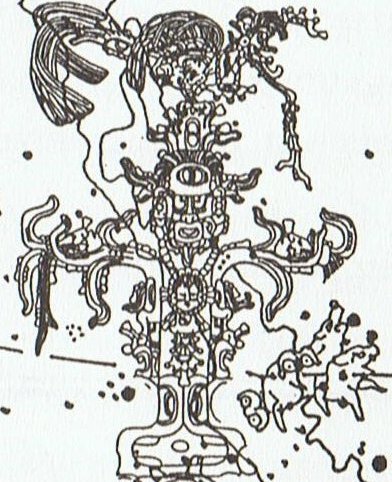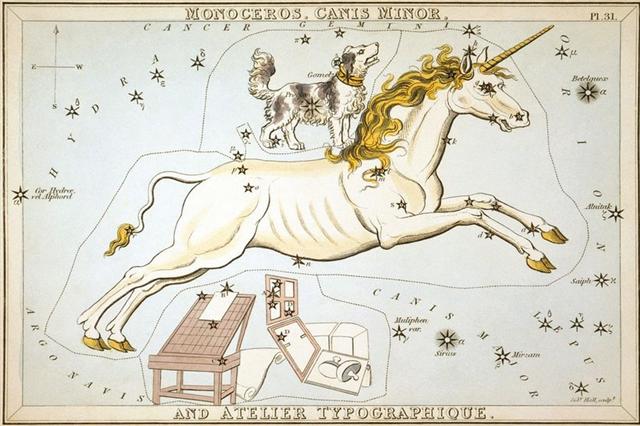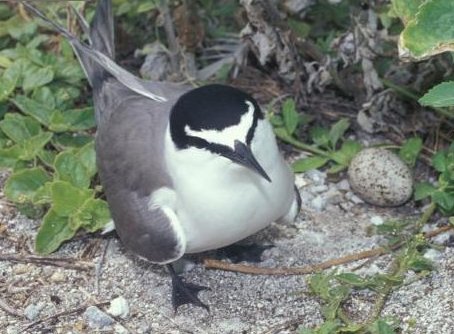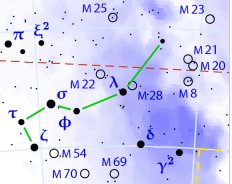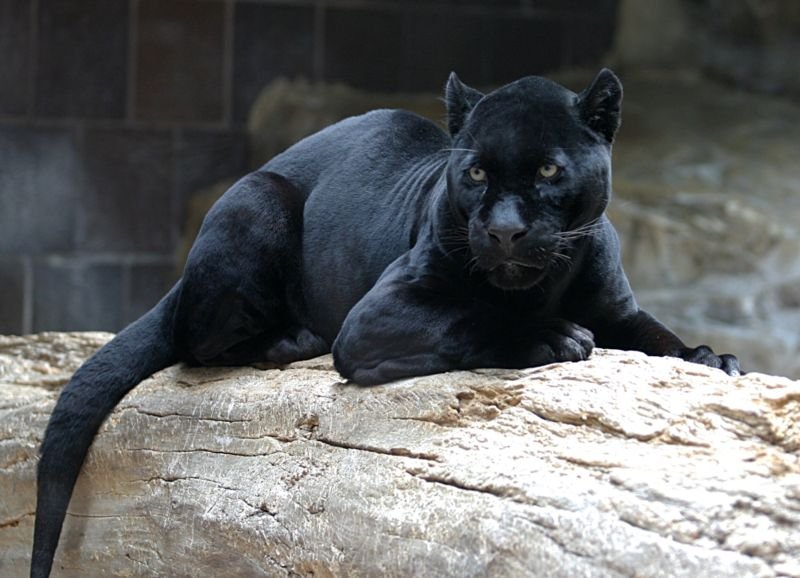There were 3 rocky islets standing in the water outside the southwestern (toga) corner of Easter Island and these 'stones' in a way corresponded to the 3 stars standing down in the Milky Way (Nile) before a New Land could be reached up at Gemini:
But of course these 3 'handsome sons of Te Taanga who were standing in the water' (Nga Kope Ririva Tutuu Vai a Te Taanga) were not equal to (≠) the 3 stars at the head of Monoceros. Although Barthel (p. 41) has suggested they may have represented stars he did not reveal which: ... In two cases, there is direct agreement with the names of stars used by the Easter Islanders: compare he kope riva with name 1 nga kope ririva ... and he pou, Sirius (α Canis Majoris), with name 8 te pou ... Makemson has no information regarding any star with the name He Kope Riva or similar, but we can guess Barthel may have thought of the Horn (tara) of Monoceros:
Mother Nature does not provide us with identities and equality (=) exists only in the 'smoking mirror' mind of man. The morning of today is not the same morning as that of yesterday - but they correspond (≈) to each other. Otherwise we could not use the same word for them. They are similar but do not occupy the same place in time-space. And if they were, they would not be a pair but be perceived as a single entity (event). ... On the twenty-fifth day of the first month (Vaitu Nui), Ira and Makoi set sail; on the first day of June ('Maro'), the bow of Ira's canoe appeared on the distant horizon, came closer and closer on its course, and sailed along, and finally (one) could see the (new home) land. The canoe reached the islets (off the coast), and Ira saw that there were three such islets. Ira said, 'Hey you, crew of young men, the vision of Hau Maka, our father, which he revealed to me, has come true. There are 'the handsome sons of Te Taanga, who are standing in the water', for this is the name that the dream soul of Hau Maka gave them. Unforgotten (? kai viri kai viri) are they, these three. And therefore this is the (right) land lying there; this is Te Pito O Te Kainga, which also received its name from the dream soul.' The Navel of the Land (Te Pito O Te Kainga) was a name applied to the whole of Easter Island and we can deduce that probably the corresponding (Navel) Button star at the right foot of Pollux (Po-Lux) in some way also represented the whole of the new Land (on the eastern bank of 'the Nile'). A navel pars pro toto should represent a newborn Land and Te Pito O Te Kainga ≈ Al Zirr. ... One morning Helius yielded to his son Phaëton who had been constantly plaguing him for permission to drive the sun-chariot. Phaëton wished to show his sisters Prote and Clymene what a fine fellow he was: and his fond mother Rhode (whose name is uncertain because she had been called by both her daughters' names and by that of Rhode) encouraged him. But, not being strong enough to check the career of the white horses, which his sisters had yoked for him, Phaëton drove them first so high above the earth that everyone shivered, and then so near the earth that he scorched the fields. Zeus, in a fit of rage, killed him with a thunderbolt, and he fell into the river Po. His grieving sisters were changed into poplar-trees on its banks, which weep amber tears; or, some say, into alder-trees ...
Menkaure prolonged his life by turning night into days in order to live for 12 'years': ... There came in reply a second message from the oracle - 'for this very reason is thy life brought so quickly to a close - thou hast not done as it behoved thee. Egypt was fated to suffer affliction one hundred and fifty years - the two kings who preceded thee upon the throne understood this - thou hast not understood it'. Mycerinus, when this answer reached him, perceiving that his doom was fixed, had lamps prepared, which he lighted every day at eventime, and feasted and enjoyed himself unceasingly both day and night, moving about in the marsh-country and the woods, and visiting all the places he heard were agreeable sojourns. His wish was to prove the oracle false, by turning night into days and so living twelve years in the space of six ... Looking at the Full Moon in ºJune 30, when at the time of Gregory XIII the Sun had reached Sirius, it would have become clear that the 'year' was at its end. Because beyond Nunki came the beginning of Water. ... This [σ] has been identified with Nunki of the Euphratean Tablet of the Thirty Stars, the Star of the Proclamation of the Sea, this Sea being the quarter occupied by Aquarius, Capricornus, Delphinus, Pisces, and Pisces Australis. It is the same space in the sky that Aratos designated as Water ... Land ought to begin at the opposite side of the sky (year) compared to Water, viz. at Al Zirr (The Navel Button). And by shifting from the time of rongorongo to the time of Gregory XIII, the Fishhook at Ga2-11 would be at heliacal Sirius, in day 12 counted from the perfect little Rei at the end of line Ga1:
The Moon was present both in winter and in summer, but Sun only in summer (with his Smoking Mirror tanist ruling in winter). Therefore 6 Sun 'years' in a way would correspond to 12 Moon 'years'. First Menkaure seems to have lived for 6 'years' (precessional days), from *84 (Ga1-20 at Heka) up to and including Ga1-25 (at Praja Pāti, Lord of Created Beings, δ Aurigae):
But then followed the last day of Menkaure, his 7th day, when the Winnowing Basket (Nash, γ Sagittarii) was at the Full Moon out in the Milky Way River:
The sleepy (moe) dormouse was turned upside down into the t-pot because the Full Moon was at γ Sagittarii, the Winnowing Basket.
If Menkaure changed sex - lived in the nights as if they were days - then we could continue to read as if the nakshatra stars were heliacal, prolonging his life until Nunki: ... Atea then became the wife of Rua-tupua-nui, Source of Great Growth, and they became the parents of all the celestial beings, first the shooting stars, then the Moon and the Sun, next the comets, then the multitude of stars and constellations, and finally the bright and dark nebulae. When this tremendous task had been accomplished Atea took a third husband, Fa'a-hotu, Make Fruitful. Then occurred a curious event. Whether Atea had wearied of bringing forth offspring we are not told, but certain it is that Atea and her husband Fa'a-hotu exchanged sexes. Then the [male] eyes of Atea glanced down at those of his wife Hotu and they begat Ru. It was this Ru who explored the whole earth and divided it into north, south, east, and west ...
... The jaguar learned from the grasshopper that the toad and the rabbit had stolen its fire while it was out hunting, and that they had taken it across the river. While the jaguar was weeping at this, an anteater came along, and the jaguar suggested that they should have an excretory competition. The anteater, however, appropriated the excrement containing raw meat and made the jaguar believe that its own excretions consisted entirely of ants. In order to even things out, the jaguar invited the anteater to a juggling contest, using their eyes removed from the sockets: the anteater's eyes fell back into place, but the jaguar's remained hanging at the top of a tree, and so it became blind. At the request of the anteater, the macuco bird made the jaguar new eyes out of water, and these allowed it to see in the dark. Since that time the jaguar only goes out at night. Having lost fire, it eats meat raw. It never attacks the macuco - in the Apapocuva version, the inhambu bird, also one of the Tinamidae ... |
||||||||||||||||||||||||||||||||||||||||||||||||||||||||||||||||||||||||||||||||||||||||||||||||||||||||||||||||||||||||||||||||||||||||||||||||||||||||||||||||||||||||||||||||||||||

